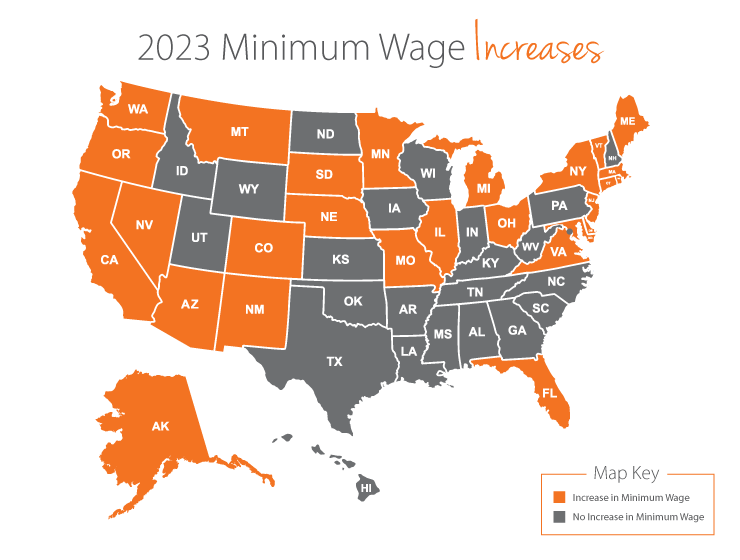January
Contact
Kristin Higgins
Public Policy Center
Phone: 501-671-2160
Email: khiggins@uada.edu
University of Arkansas System Division of Agriculture
Cooperative Extension Service
2301 S. University Avenue
Little Rock, AR 72204
What is the Minimum Wage in Arkansas?
For several years in a row, Arkansas’ minimum wage rose on New Year’s Day as part of a gradual increase approved by voters in two statewide elections.
Minimum hourly pay rose incrementally from $6.25 in 2014 to $11 per hour in 2021 as a result of two citizen-initiated state laws. And that’s where the hourly rate will stay without an increase from legislators or another statewide ballot issue.
State legislators begin a new legislative session on Jan. 9. It's unlikely a higher minimum wage will come out of the legislative process. Arkansas lawmakers last approved an increase to the state's minimum wage in 2006, when they increased the rate from $5.15 per hour to $6.25 per hour.
Minimum Wage Across the Country
Although Arkansans won’t see a base wage increase in 2023, rates in more than 20 other states will go up, according to Paycor.com, a human resources company in Ohio.
Higher minimums in these states are the result of a recent ballot issues or past decisions to tie minimum wage to inflation or the Consumer Price Index. Eleven states have inflationary requirements, according to the National Conference of State Legislators.
Map Source: Paycor
Florida is the only state in the southeast where base pay will increase this year, although Floridians will have to wait until Sept. 30, 2023 to see minimum wage increase from $11 an hour to $12 an hour.
California remains at the top when it comes to minimum wage, where the rate this year increased to $15.50 an hour. (D.C. would be at the top if it were a city rather than a district, as minimum wage is $16.10 an hour in the nation’s capital.)
Georgia and Wyoming remain at the bottom rung of the wage scale. Technically the minimum hourly wage
in these two states is $5.15, but employers there must follow the federal minimum
wage of paying at least $7.25 an hour.
Minimum Hourly Wage in Arkansas and Surrounding States
|
|
2022 Minimum Wage |
2023 Minimum Wage |
|
Arkansas |
$11 |
No change |
|
Louisiana |
$7.25 (federal, no state minimum) |
No change |
|
Mississippi |
$7.25 (federal, no state minimum) |
No change |
|
Missouri |
$11.15 |
$12.00 |
|
Oklahoma |
$7.25 |
No change |
|
Tennessee |
$7.25 (federal, no state minimum) |
No change |
|
Texas |
$7.25 (federal, no state minimum) |
No change |
Fewer Americans Make Minimum Wage
The number of people in the United States earning the federal minimum wage or less continues to decline. According to the Bureau of Labor Statistics, 181,000 workers earned the federal hourly minimum wage in 2021 compared to 392,000 in 2019. Working 40 hours a week at the federal minimum wage would earn someone $15,080 a year.
About 910,000 people earned wages below the federal rate in 2021. The report doesn't detail why someone is making less than the federal rate, but for example, people with disabilities and full-time students can be paid less than the federal minimum wage.
Combined, those 1.1 million workers made up 1.4% of all hourly paid workers.
Arkansas' minimum wage requirements apply to employers with four or more employees in industries that are not exempt by state law. For example, some agricultural activities and newspapers with small circulation are exempt from minimum wage requirements. Also, allowances are made for tips to be part of the hourly minimum wage for occupations in which gratuities are customary.
Tipped workers, such as restaurant workers, receive a base pay of $2.63 in Arkansas, a rate slightly higher than the federal minimum of $2.13 an hour. If those workers do not make the $11 minimum an hour through guests tipping, employers must cover the remaining amount.
Read more information about the minimum wage from the Department of Labor
Average Earnings and Median Income in Arkansas
The 2021 Rural Profile of Arkansas, published by the Community, Professional and Economic Development unit at the University of Arkansas System Division of Agriculture, noted a 3.7% increase in the average earnings per job in Arkansas from 2010 to 2018.
On average, Arkansans earn about 24% less per job compared to the national average. The average earnings per job in Arkansas in 2018 was approximately $47,272 compared to $62,321 nationally.
Read more about urban versus rural earnings in the 2021 Rural Profile at https://www.uaex.uada.edu/business-communities/economic-analysis/rural-profile-of-arkansas.aspx.
